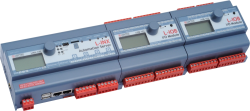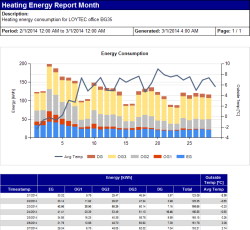LWEB-900 now supports creation of reports based on trend logs, e.g. to document the energy consumption in a building.
Additionally, it is possible to create schedulers that trigger a report or enable an alarm receiver. A number of features has also been added to the LWEB-900 alarm management.
It is now possible to configure the priority of system alarms, apply a custom filter for alarm notifiers, etc.
LWEB-900 also offers the possibility to copy a graphical view to an L-VIS device. In the user configuration dialog, a new option is available that allows to entirely hide objects
on which the user has no read access. Moreover, it is possible to export the identification key schema from one LWEB 900 project and import it in a different one.
The chart view also faced a number of improvements. It supports dynamic scaling, linear interpolation, and other new functions. Last but not least,
the master device manager features a new dialog that displays all files imported or uploaded from LOYTEC devices. This dialog allows removing unused files quickly.
 From now on, generic schedulers can be created, that are neither CEA-709 nor BACnet objects.
This is beneficial for creating technology-independent applications. Also the optimum start algorithm faced major changes.
Up to now, it was limited to the use of a SNVT-tod-event in a CEA-709 scheduler. From now on, all schedulers (including BACnet and generic schedulers)
support timeToNext and nextState data points for implementing optimum start algorithms also for those technologies. Favorites also come up with new features.
They can now be trended, scheduled and receive an alarm condition. Historic filters can now be applied to Favorites. Additionally, Favorites can be used in e-mail templates, math objects,
and connections like any other data points. Historic filters have been extended by a generic delta calculation between any of the defined filter items or the current value.
This way, it is no longer necessary to create a separate math object to calculate the consumption of the previous month.
Another new function is the organization of application objects such as math objects, e-mail templates, and alarm logs in folders.
The Web interface features live updates of values in the data point list, a breadcrumb navigation for faster access to sub-folders,
a new firmware upgrade menu, and also a trend overview page that displays current trend log states.
From now on, generic schedulers can be created, that are neither CEA-709 nor BACnet objects.
This is beneficial for creating technology-independent applications. Also the optimum start algorithm faced major changes.
Up to now, it was limited to the use of a SNVT-tod-event in a CEA-709 scheduler. From now on, all schedulers (including BACnet and generic schedulers)
support timeToNext and nextState data points for implementing optimum start algorithms also for those technologies. Favorites also come up with new features.
They can now be trended, scheduled and receive an alarm condition. Historic filters can now be applied to Favorites. Additionally, Favorites can be used in e-mail templates, math objects,
and connections like any other data points. Historic filters have been extended by a generic delta calculation between any of the defined filter items or the current value.
This way, it is no longer necessary to create a separate math object to calculate the consumption of the previous month.
Another new function is the organization of application objects such as math objects, e-mail templates, and alarm logs in folders.
The Web interface features live updates of values in the data point list, a breadcrumb navigation for faster access to sub-folders,
a new firmware upgrade menu, and also a trend overview page that displays current trend log states.
The OPC server on the devices, which support security, has been extended by an OPC UA server.
It supports the OPC UA binary protocol and exposes the same OPC tags as the OPC XML-DA server.
OPC UA offers superior security features as well as slimmer data transfers.
The L-IOB I/O Controllers LIOB-48x and LIOB-58x now feature a built-in CEA-852 Configuration Server that allows - without an additional device - to set up channels both for CEA-709-over-IP and
global connections.
Please find a complete list of new features in the respective user manuals.
|




